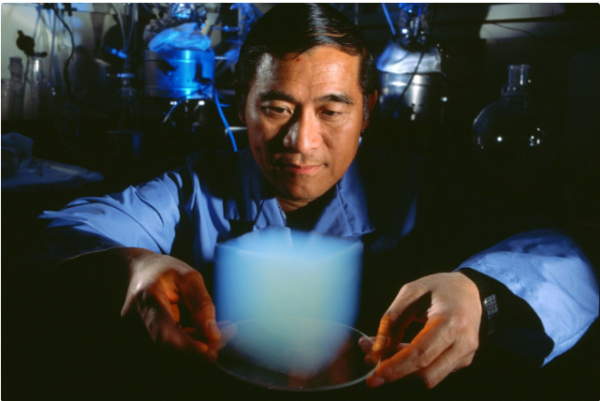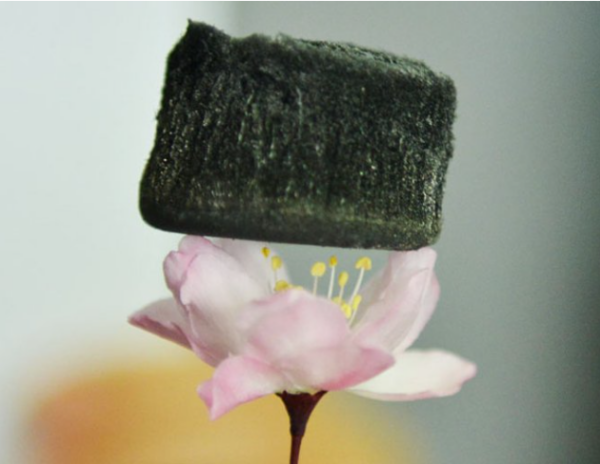Being able to successfully 3D print using the world’s lightest material – graphene airgel promises to open a new chapter for the materials industry.
Graphene airgel is the lightest material in the world with a weight 7.5 times lighter than air, 1 cubic meter of graphene airgel weighs less than 160 grams. Graphene airgel is even 12% lighter than the world’s second lightest material, aerographite.
There is a very good question: if it is lighter than air, why can’t this material fly? That’s because there are many spaces between the molecules of this material that allow air to penetrate, keeping it from flying up.

Graphene airgel is the lightest material in the world.
Having a humorous nickname “frozen smoke”, airgel is a solid that is flexible, conductive, resistant to compression and has good absorbency.
Because of the strange properties of this material, scientists have discovered many potential applications from invisibility cloaks to environmental cleanup. Just 1 gram of airgel is enough to absorb some materials up to 900 times their weight such as oil. A completely cheaper method than the market.
Currently, in many studies and tests, silica airgel is the most popular shape used to research airgel. The difficulty with this material is that it is not easy to produce. However, scientists have diligently researched and successfully found a way to 3D print the lightest material in the world.
Recently, scientists from the University. New York State and University. The state of Kansas, USA said it was able to 3D print airgel materials for the first time. The entire process is controlled automatically and evenly on all material layers.

A block of graphene airgel can float above grass or even on top of flowers.
The airgel itself is a layer of pure carbon atoms, thick and two-dimensional. They fold together into a hexagonal honeycomb lattice. To produce graphene airgel, researchers will have to freeze layers of graphene and stack them into a three-dimensional structure.
According to ScienceAlert, using 3D printing technology to successfully manufacture graphene airgel for the first time shows the remarkable efforts of researchers. Because the molecular structure of graphene airgel is considered very difficult to 3D print.
Researcher Akshat Rathi in the team that successfully 3D printed graphene airgel said:
“Normally to 3D print graphene airgel, the main material will be mixed with other components, such as polymer to be able to be inkjet printed on a printer. Once the structure has been shaped, the polymer will be separated from the material. main material after another chemical process. However, in the case of airgel, this method can destroy the crystal structure of the airgel.”
The solution proposed by the research team is graphene oxide – a form of graphene combined with oxygen molecules. The team mixed the compound with water and placed it on a surface cooled to -25 degrees Celsius. At this temperature, the researchers were able to instantly freeze each individual layer of graphene and create creating a three-dimensional graphene structure.
Rathi also added that after the process of creating the 3D structure is completed, they will proceed to remove the surrounding ice blocks by using liquid nitrogen to freeze-dry the water and separate it from the surface of the object without affects the structure.
The layer of airgel material with a 3D structure will continue to be applied with heat to separate oxygen atoms. The result will be only graphene airgel. According to Rathi, “the resulting solid will vary in density from 0.5kg/m3 to 10kg/m3. The lightest Graphene airgel ever successfully produced weighs about 0.16kg/m3.” .
The birth of Aerogel originates from a story told in the late 1920s, when Samuel Kistler (1900-1975), an American chemistry professor, bet with his colleague Charles Learned that “there exists a non-liquid gel”. Of course, no one believed what he said was true. Because the liquid properties are inherent properties of gels that have been known for a long time.
With his perseverance and determination, after many trials and many failures, Kistler finally found a gel in a gaseous state (not a liquid state), a new type of gel that had never been known before. Come, no one even imagined it. He became the first person to replace the liquid state of gel with a gaseous state, and named it “Aerogel”. In 1931, he published his findings in the article “Coherent Expanded Aerogels and Jellies”, published in the scientific journal Nature.
Aerogels make excellent insulators because they virtually neutralize two of the three methods of heat transfer – conduction (they are composed almost entirely of insulating gases that are very poor conductors of heat) and convection ( Their microstructure prevents net gas movement). Aerogels can even have a thermal conductivity that is less than that of the gas they contain – a phenomenon known as the Knudsen effect.
Although very light, an object made of Aerogel is capable of “piggybacking” another object weighing 500 to 4,000 times its own weight. When it first appeared, Aerogel was used in every field imaginable, from makeup products for women to more romantic things like making paint for… napalm bombs. They are also used in cigarette filters or refrigerator insulation. Currently, Aerogel can be found in fields such as: Swimwear production; Clothing for firefighters; Glass door; Rocket; Paint; Cosmetics; Nuclear weapons…..










